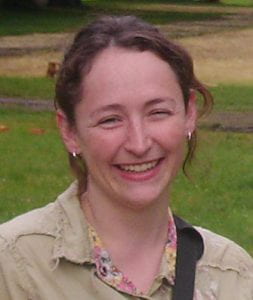Faculty/Research
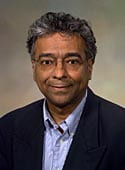 Abhay Ashtekar
Abhay Ashtekar
Eberly Chair and Evan Pugh Professor of Physics
Research Interests:
Loop Quantum Gravity, General Relativity, Cosmology, Gauge Theories, Generalizations of Quantum  Mechanics, Geometry and Physics.
Mechanics, Geometry and Physics.
In quantum gravity, my current research focuses on cosmology and black holes. Thanks to the contributions from dozens of researchers, loop quantum cosmology (LQC) has made significant advances over the last five years. The big-bang and the big-crunch singularities have been resolved in homogeneous models. As a result, LQC space-times are vastly larger than what Einstein had us believe. Details of Planck scale physics have also been worked out in these models. Recently, a framework was introduced to analyze cosmological perturbations using quantum fields in quantum space-times. The framework allows one to adequately handle perturbations whose seeds lie in the deep Planck regime, where matter densities and space-time curvature is some 11 orders of magnitude higher than that at the onset of standard inflation. We know that some of these seeds would not be washed away by the many e-foldings of inflation and can give rise, for example to non-Gaussianities. The question of whether such seeds are in fact produced during the big bounce, that replaces the big bang in LQC, is under active investigation.
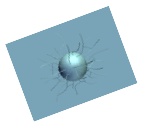 Research on LQC has also provided important new insights into full loop quantum gravity (LQG). These include the emergence of a relational time variable, techniques to find the physical sector of the theory including the so-called ‘Dirac’ observables, concrete support for the spin foam paradigm, insight into how entropy bounds can arise without a priori holographic input, and new physical effects – such as a brand new repulsive force – that emerge in the Planck regime from the specific quantum geometry that underlies LQG. There is considerable ongoing research on such issues to create a reliable bridge between LQG and LQC.
Research on LQC has also provided important new insights into full loop quantum gravity (LQG). These include the emergence of a relational time variable, techniques to find the physical sector of the theory including the so-called ‘Dirac’ observables, concrete support for the spin foam paradigm, insight into how entropy bounds can arise without a priori holographic input, and new physical effects – such as a brand new repulsive force – that emerge in the Planck regime from the specific quantum geometry that underlies LQG. There is considerable ongoing research on such issues to create a reliable bridge between LQG and LQC.
The fact that LQG can provide specific quantum extensions of classically singular space-times is also being used in black holephysics. Analysis is driven by conceptual issues, such as the quantum nature of the big-bang and the issue of information loss inHawking evaporation, and uses advanced techniques at the interface of geometry, mathematical physics and computational science. Quantum geometry underlying LQG also accounts for black hole entropy. Here, the micro-states that feature in the statistical mechanical counting arise directly from the ‘atoms’ of the horizon quantum geometry, rather than from a hypothetical system of bosons and fermions that is ‘equivalent’ to a black hole. Furthermore, the calculation encompasses ‘isolated horizons’ which are more general than the event horizons of stationary black holes. In particular, cosmological horizons are naturally included.
In classical general relativity, I have been interested in the asymptotic structure of space-time, gravitational radiation theory, Lagrangian and Hamiltonian formulations without infinite counter-term subtractions and especially in the conceptual and physical understanding of dynamical black holes in the full, non-linear regime of general relativity. This last work in particular has a strong interface with numerical relativity where it provides tools to extract reliable physics from black hole simulations.
Further information: http://igc.psu.edu/people/Ashtekar/
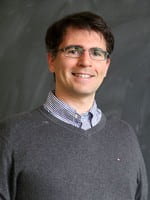 Eugenio Bianchi
Eugenio Bianchi
Associate Professor of Physics
Research Interests:
Loop quantum gravity and spin foams, Quantum nature of black hole entropy, Cosmology and quantum fields in de Sitter space, Entanglement and thermalization.
My current research studies the role of quantum entanglement – a phenomenon in which the individual quantum state of interacting particles cannot be described – in gravitational events such as the evaporation of a black hole and the dynamics in the primordial state of the universe. The main objective of my research is to understand the quantum nature of space-time and the entanglement between its elementary constituents. The ideas and methods I work with have applications in the theories of loop quantum gravity and quark-gluon-plasma thermalization, as well as in other areas of physics.
Martin Bojowald
Professor of Physics
The main aim of my current research is a deeper understanding of quantum gravity based on possible physical phenomena it implies, possibly leading to crucial tests of its theoretical ingredients. As the initiator of loop quantum cosmology, I apply the general techniques of loop quantum gravity to specific conditions such as those found in the early universe or in black holes. In both applications, classical descriptions by general relativity lead to a point, at the big bang or inside black holes, where space-time becomes singular and the classical theory breaks down. Several models of loop quantum cosmology are being developed and studied in detail where such singularities do not occur; they are rather prevented by quantum effects giving rise to repulsive contributions to the gravitational force. Current research focuses on a detailed understanding of this process by physical and geometrical pictures as well as on generalizing such scenarios to more complicated situations.
phenomena it implies, possibly leading to crucial tests of its theoretical ingredients. As the initiator of loop quantum cosmology, I apply the general techniques of loop quantum gravity to specific conditions such as those found in the early universe or in black holes. In both applications, classical descriptions by general relativity lead to a point, at the big bang or inside black holes, where space-time becomes singular and the classical theory breaks down. Several models of loop quantum cosmology are being developed and studied in detail where such singularities do not occur; they are rather prevented by quantum effects giving rise to repulsive contributions to the gravitational force. Current research focuses on a detailed understanding of this process by physical and geometrical pictures as well as on generalizing such scenarios to more complicated situations.
In addition to providing a well-defined description of the universe at the big bang or of black holes, quantum gravity also implies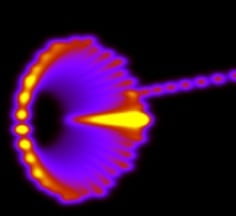 small deviations from classical behavior on larger scales. For an evaluation and eventual comparison with observations these corrections, arising from several different effects, are currently being derived for effective equations of cosmological perturbation theory. This can constrain possible quantization choices which will help in pinning down specifics of a quantum theory of gravity. Moreover, extrapolating the equations of quantum gravity even further back in time gives us indications as to what the universe could have been like even before the big bang. While precise predictions are difficult in such long-term extrapolations, current models can already tell us about possible limitations to our knowledge of properties of a pre-big bang universe.
small deviations from classical behavior on larger scales. For an evaluation and eventual comparison with observations these corrections, arising from several different effects, are currently being derived for effective equations of cosmological perturbation theory. This can constrain possible quantization choices which will help in pinning down specifics of a quantum theory of gravity. Moreover, extrapolating the equations of quantum gravity even further back in time gives us indications as to what the universe could have been like even before the big bang. While precise predictions are difficult in such long-term extrapolations, current models can already tell us about possible limitations to our knowledge of properties of a pre-big bang universe.
 Jacob Bourjaily
Jacob Bourjaily
Associate Professor of Physics
Research Interests:
Quantum Field Theory, Scattering Amplitudes, High Energy Theoretical Physics, Mathematical Physics
 Murat Gunaydin
Murat Gunaydin
Professor of Physics
Office: 303F Osmond Lab, University Park, PA
Tel: 814-863-0144
Email: murat AT phys.psu.edu
Research Interests:
M/Superstring Theory, Supergravity, AdS/CFT Dualities, Exceptional Groups and Related Algebraic and Geometric Structures, Representations of Noncompact Groups and Supergroups and their Applications, Algebraic Foundations of Quantum Mechanics, Generalized Spacetimes defined by Jordan Algebras.
One focus of my current research is the continuation of my work on the construction and classification of novel supergravity theories and their gaugings in various dimensions and AdS/CFT dualities. Of particular interest are gauged supergravity theories that describe the low energy effective theories of flux compactifications and those that are relevant for understanding AdS/CFT dualities in M/Superstring theory.
Another focus of my current research is the problem of understanding how the spectra of various superstring theories or M-theory are related to the unitary representations of their non-perturbative symmetry groups or supergroups. Towards this goal I have done extensive work on the unitary representations of continuous U-duality groups of supergravity theories, some of which arise as low energy effective theories of compactified M-theory or superstring theories. I have also been studying the unitary representations of spectrum generating symmetry groups in five and four dimensional supergravity theories and their applications to the BPS black hole spectra.
U-duality groups of five dimensional supergravity theories with homogeneous scalar manifolds admit extensions to spectrum generating generalized conformal groups. Similarly, U-duality groups of corresponding four dimensional theories admit extensions to spectrum generating quasiconformal groups. Quasiconformal realization of the spectrum generating symmetry group E8(8) of the maximal supergravity in four dimensions, constructed in 2000, was the first known geometric realization of E8. Remarkably, quasiconformal realizations exist for different real forms of all Lie groups and they leave invariant a generalized light-cone defined by a quartic distance function. Furthermore, the quantization of geometric quasiconformal realization of a noncompact group leads directly to its minimal unitary representation.
Recent work on quasiconformal realizations of noncompact groups and matter coupled supergravity theories have established more deep connections between representation theory of noncompact groups, quasiconformal actions and supersymmetry. I am continuing my work in this field to develop these connections further and investigate their implications for physics, in particular for M/Superstring theory, as well as for mathematics.
Publications: See my papers listed in Spires:
http://inspirehep.net/search?p=find+a+gunaydin,+m.
Recent Talks:
- “U-duality as Conformal and Quasiconformal Symmetry, Extremal Black Holes and Representation Theory,”
at the CERN Theory Institute Black Holes: A Landscape of Theoretical Phsyics Problems, August 25 – October 8, 2008. - “Lorentzian, Conformal and Quasiconformal Geometries,
Supersymmetry and Representation Theory”, talk given at the Workshop on Holonomy Groups and Applications in String Theory, Hamburg, Germany, July 14-18, 2008. - From d=6, N=1 to d=4, N=2, No Scale Models and Jordan Algebras,” talk from the conference “30 Years of Supergravity in Paris,” October 16-20, 2006.
- “Minimal Unitary Representations of U-Duality Groups, Conformal Quantum
Mechanics and Extremal Black Holes”, talk given at the KITP Workshop: Mathematical Structures in String Theory, December 9, 2005.
Adrian Ocneanu
Professor of Mathematics
http://science.psu.edu/news-and-events/2005-news/math10-2005.htm
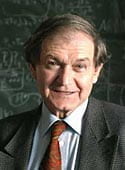 Sir Roger Penrose
Sir Roger Penrose
Francis and Helen Pentz Distinguished Visiting Professor of Physics and Mathematics
 Radu Roiban
Radu Roiban
Professor of Physics
Research Interests:
String Theory, Quantum Field Theory, Gauge/String duality, Integrable Models, UV behavior of supergravity theories
String theory is the only framework unifying all known interactions in a quantum mechanically consistent way. Studying it will lead to understanding phenomena ranging from particle physics to quantum gravity. My past work covers a wide variety of topics in string and quantum field theory, from formal aspects of string theory to phenomenological constraints on the parameters of the Minimal Supersymmetric Standard Model, from subjects of fundamental importance for uncovering the principles of string theory to important phenomenological problems related to high energy particle physics.
Part of my current work focuses on gauge/string duality in the form of the AdS/CFT correspondence and its generalizations. Certain aspects of both sides of this correspondence are captured by integrable models. Work along this line could lead to the exact solution of planar maximally supersymmetric gauge theory in four dimensions and ultimately to a handle on confinement.
It is widely believed that point-like gravity theories are ill-behaved at high energies. A way around this problem has been provided by superstring theory, which postulates that particles are not point-like, but objects extended in one dimension. Because strings are fuzzy and spread out, their interactions at very short distances are much weaker than those of point-like particles. This cures the quantum gravity infinities. It remains nevertheless an open problem whether a finite point-like quantum gravity theory exists. My collaborators and I have been studying a point-like theory of quantum gravity — N=8 supergravity — which may turn out to be just such a theory.
This interest and the necessary calculational techniques relate closely to ongoing work on the calculation of scattering amplitudes in gauge theories.
Sarah Shandera
Associate Professor of Physics
Research Interests:
Cosmology, Quantum Field Theory
The energy scale of the primordial universe was many orders of magnitude above anything we can test in the laboratory, and both quantum particle physics and general relativity must be used to describe the primordial era. As a result, early universe cosmology plays an important dual role in theoretical physics: insisting that high energy frameworks like string theory naturally explain the primordial universe is a key test for those theories. On the other hand, specific attempts to realize early universe models in particle physics, even though often not completely successful, have enormously expanded the phenomena cosmologists are now testing observationally. But, despite more than two decades of work, theories of the primordial universe remain largely phenomenological. My research continues to push for a deeper theoretical understanding of the early universe, and of the related implications for the framework of particle physics at very high energies. Although these questions have been asked for quite some time, I take a relatively new approach that focuses on the interacting quantum theory in the primordial universe.
Until quite recently, work on the very early universe required only calculations of the classical gravitational interaction (to source the space-time geometry, usually inflating) and of the lowest order quantum theory of the matter present (to calculate the amplitude of fluctuations, which generate the observed primordial density inhomogeneities). There are two excellent reasons for this: observations suggest that the early universe underwent nearly de Sitter expansion and had nearly Gaussian inhomogeneities. In many of the earliest models those two conditions made interactions essentially irrelevant. However, recent work on particle physics models has made it clear that there are many interactions that could have been present among the primordial matter fields and that are consistent with the current observational picture.
Those interactions lead to new observables and to new consistency tests of the theories. Most straightforwardly, evidence of interactions may reveal the spectrum of particles present in the primordial universe and their connection to the particle physics we are familiar with at lower energies. The interactions also provide new ways to differentiate between scenarios that are otherwise observationally indistinguishable. Intriguingly, some classes of interactions crucially change the story for one of the most confusing (and likely unobservable) consequences of inflation: eternal inflation. In addition, we are moving toward a better understanding of the implications if the next decade of observations brings no evidence of any primordial interactions. Put together, these points indicate that studying the interacting theory will allow us answer the most important question that the free theory could not: whether our current ideas for the primordial universe are right on a very basic level, or are just convenient parametrizations of the small number of observations we have so far.





